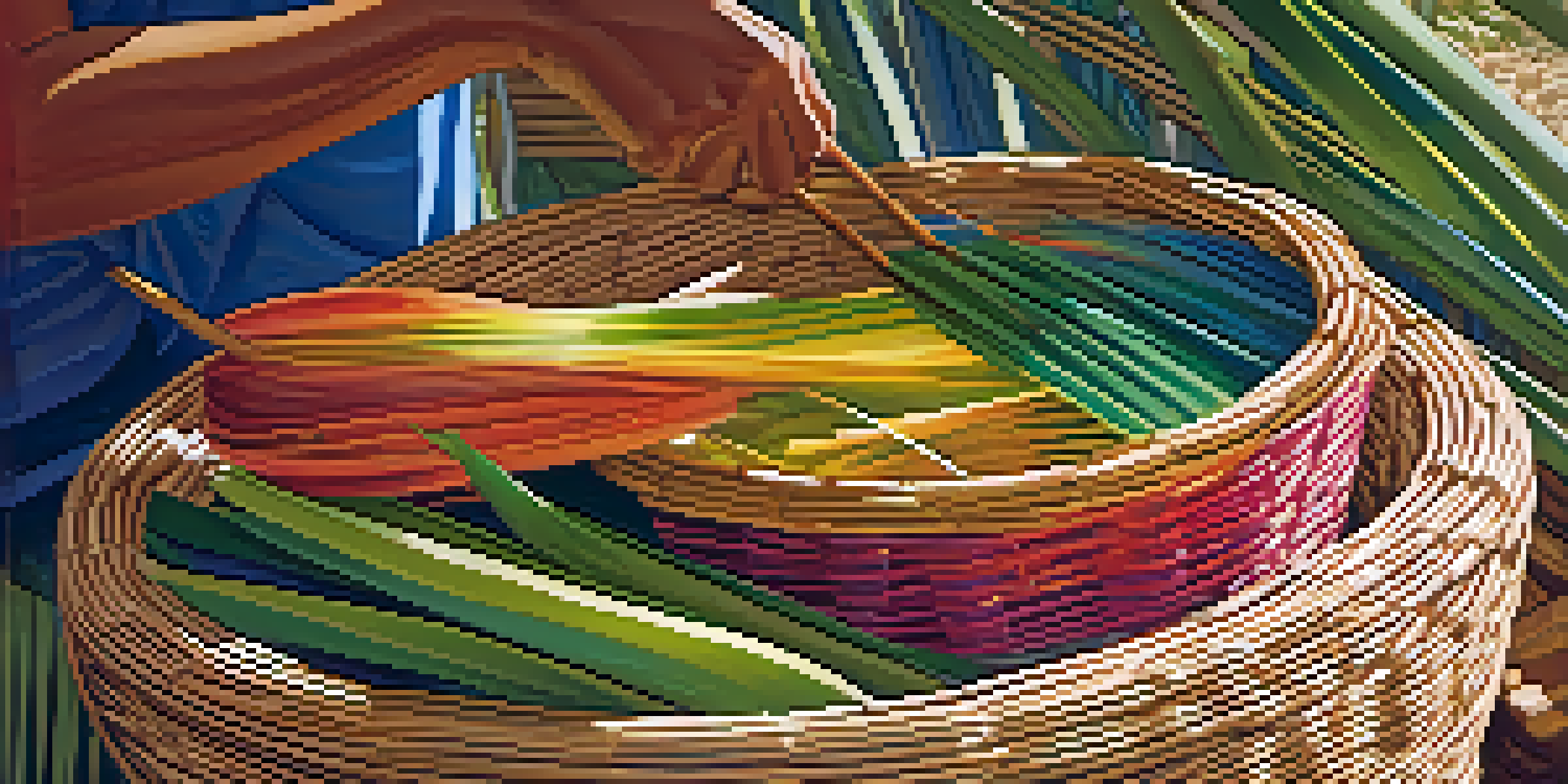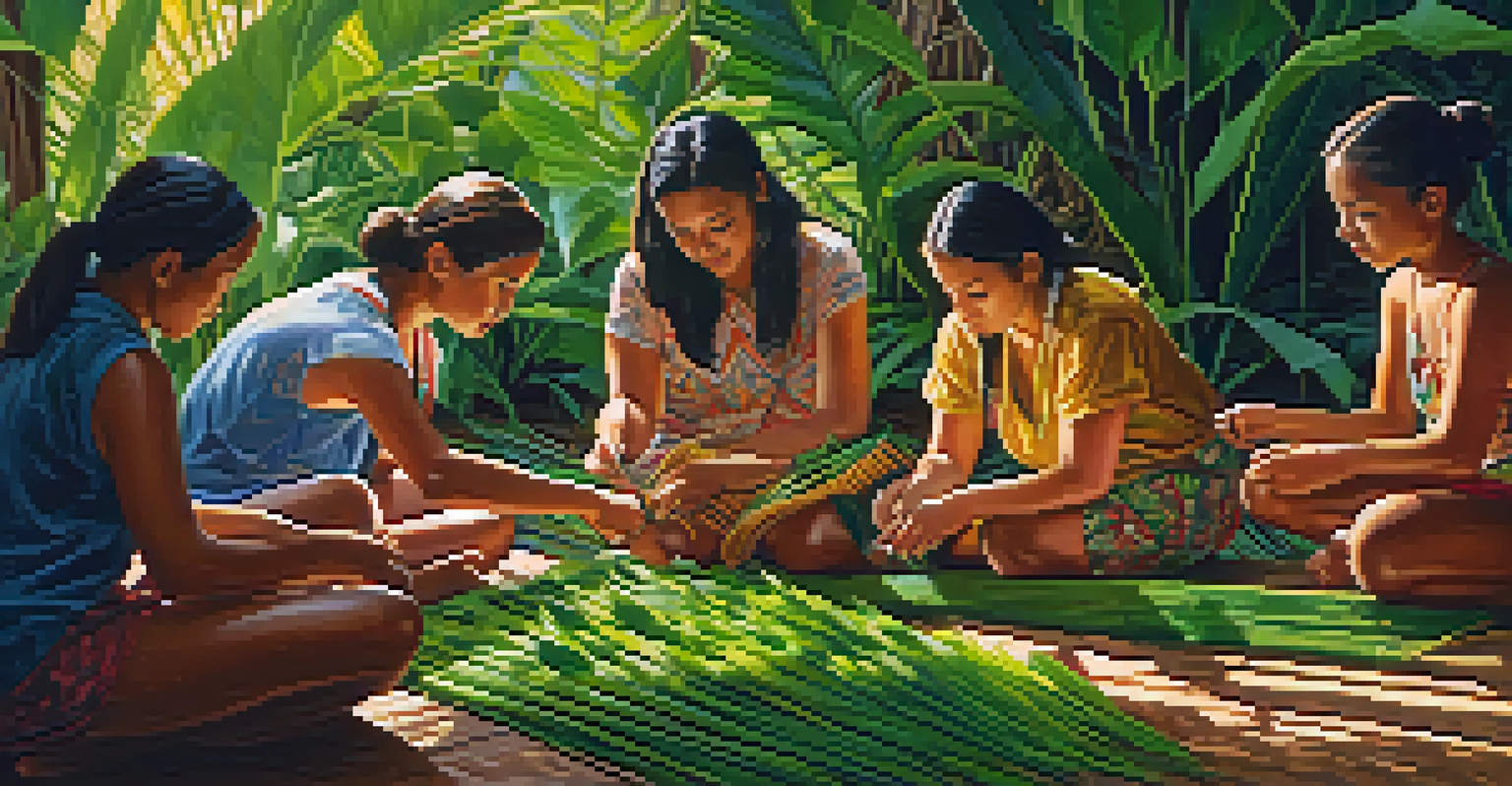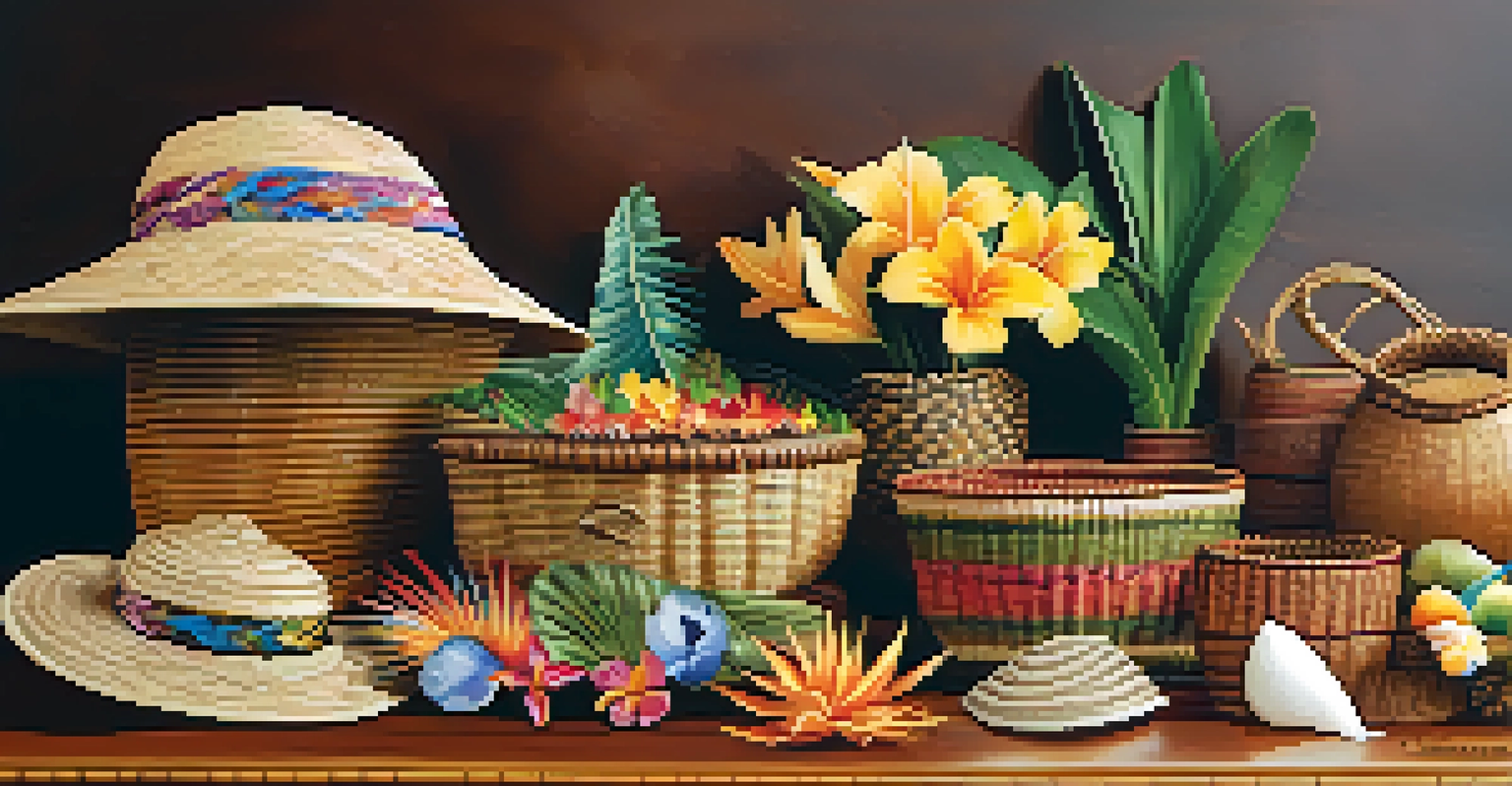Traditional Hawaiian Crafts: Weaving Stories Through Art

The Origins of Hawaiian Weaving Traditions
Hawaiian weaving has deep roots, tracing back to the early Polynesian settlers. These artisans used natural materials like pandanus leaves and ti leaves, turning them into functional and artistic pieces. The act of weaving was not just a craft; it was a way to connect with the land and the ancestors, preserving stories and traditions through each creation.
Weaving is not just a craft; it is a way to connect with the land and the ancestors.
Over generations, weaving techniques evolved, incorporating influences from various cultures that arrived in Hawaii. This blending of styles enriched the art form, allowing weavers to innovate while honoring their heritage. For instance, the introduction of new fibers and dyes transformed traditional practices, leading to vibrant and diverse outcomes.
Today, these ancient practices are celebrated and taught in communities across the islands. Weaving classes and workshops invite individuals of all ages to learn the craft, ensuring that the stories woven into each piece continue to thrive in modern times. This revival highlights the importance of passing down cultural knowledge through hands-on experiences.
Key Materials in Hawaiian Weaving
Natural materials are the heart of Hawaiian weaving, with each choice reflecting the environment. Pandanus leaves, known as 'hala,' are commonly used for their durability and flexibility. Weavers often dye these leaves using natural pigments, resulting in a spectrum of colors that tell stories of the land and sea.

Another essential material is the ti leaf, which is used primarily for its strength and glossy appearance. Ti leaves are often woven into beautiful lei or hats, serving both functional and ceremonial purposes. This connection to nature is a hallmark of Hawaiian crafts, emphasizing sustainability and respect for resources.
Hawaiian Weaving's Cultural Significance
Weaving in Hawaiian culture serves as a vital expression of identity, storytelling, and community connection.
Additionally, some artisans incorporate shells, stones, and even feathers into their woven works, adding texture and a unique touch. These elements not only enhance the aesthetic but also carry symbolic meanings, linking the craft to Hawaiian spirituality and history. Each woven item becomes a narrative, reflecting the weaver's relationship with their surroundings.
The Role of Weaving in Hawaiian Culture
Weaving is more than a craft in Hawaiian culture; it’s a vital expression of identity and community. Traditionally, woven items were used in ceremonies, celebrations, and daily life, embodying the spirit of the islands. This connection to culture helps individuals foster a sense of belonging and pride in their heritage.
The act of weaving connects us to our roots and reminds us of our shared history.
In many ways, weaving tells a story—of family, tradition, and the environment. Each piece created carries the weaver's unique touch, reflecting personal experiences and collective memories. This storytelling aspect is what makes Hawaiian crafts so rich and meaningful, as they serve as a bridge between the past and present.
Moreover, community gatherings centered around weaving create opportunities for social interaction and knowledge sharing. These events not only strengthen bonds but also promote the continuity of cultural practices. In this way, weaving acts as a thread that links generations together, ensuring that the art form remains vibrant and alive.
Modern Adaptations of Hawaiian Weaving
While traditional techniques are cherished, contemporary Hawaiian weavers are also experimenting with new ideas. This fusion of old and new results in innovative designs that resonate with today's audiences. For example, some artisans are incorporating modern patterns or materials while still honoring traditional methods.
These adaptations not only keep the craft relevant but also attract a diverse range of admirers. As more people engage with Hawaiian weaving, it opens up avenues for dialogue about cultural preservation and innovation. This evolution reflects the dynamic nature of Hawaiian culture, where tradition and modernity coexist harmoniously.
Importance of Preserving Traditions
Preserving Hawaiian weaving traditions is essential to maintaining cultural identity and passing down ancestral skills.
Additionally, social media plays a crucial role in showcasing these modern adaptations. Platforms like Instagram allow artists to share their work with a global audience, inspiring others to appreciate and engage with Hawaiian crafts. This visibility helps ensure that the art form continues to thrive while reaching new heights of creativity.
Prominent Hawaiian Weavers and Their Stories
The world of Hawaiian weaving is filled with talented artisans who have dedicated their lives to preserving this craft. Figures like Mamo Kekuawela and her innovative use of traditional techniques have inspired countless others. Their stories often highlight the struggles and triumphs of keeping cultural practices alive amidst modernization.
Each prominent weaver brings their unique perspective, often blending personal narratives with broader cultural themes. As they share their experiences, they not only educate others about the intricacies of weaving but also emphasize its significance in their lives. This storytelling aspect adds depth to the craft, allowing others to appreciate the journey behind each woven piece.
Additionally, these artisans often mentor younger generations, ensuring that their knowledge is passed down. Their commitment to teaching and sharing stories enriches the community, fostering a sense of continuity. By celebrating the achievements of these prominent weavers, we honor the legacy of Hawaiian crafts and their ongoing evolution.
Where to Experience Hawaiian Weaving Today
If you're eager to dive into the world of Hawaiian weaving, there are plenty of places to start. Many cultural centers and museums across Hawaii host workshops and classes, providing hands-on experiences for visitors and locals alike. These opportunities allow you to learn directly from skilled artisans, gaining insight into the craft's history and techniques.
You can also find weaving demonstrations at local festivals and events, where you can witness the artistry in action. These gatherings often showcase the diversity of Hawaiian crafts, allowing you to engage with the community and appreciate the cultural significance of each piece. It's a fantastic way to immerse yourself in the vibrant culture of the islands.
Modern Innovations in Weaving
Contemporary Hawaiian weavers blend traditional techniques with modern ideas, ensuring the craft remains relevant and engaging.
Moreover, numerous online platforms now offer virtual workshops, making it easier than ever to connect with Hawaiian weaving from anywhere in the world. This accessibility helps foster a global appreciation for the art form, ensuring that the stories woven through these crafts continue to resonate with audiences far beyond the shores of Hawaii.
The Importance of Preserving Hawaiian Weaving Traditions
Preserving Hawaiian weaving traditions is crucial for maintaining cultural identity and heritage. As globalization influences local practices, it’s essential to protect these ancient crafts from fading away. By honoring and practicing traditional weaving techniques, we ensure that the stories and skills of our ancestors are not lost to time.
Moreover, supporting local artisans and participating in workshops helps sustain these traditions. When communities actively engage with their cultural practices, they create a vibrant environment that encourages creativity and innovation. This collective effort to preserve weaving not only enriches the culture but also strengthens community bonds.

Ultimately, the act of weaving connects us to our roots and reminds us of our shared history. It serves as a powerful reminder of the resilience and adaptability of Hawaiian culture. By valuing and preserving these traditions, we weave a brighter future, allowing the stories of the past to inspire generations to come.